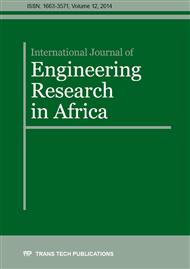[1]
R.R. Pierre, Handbook of Corrosion Engineering, John Wiley & Sons, New York, 2000.
Google Scholar
[2]
C. Cabrillac, J.S.L. Leach, P. Marcus, The cost of corrosion in the EEC. Metals and Materials. 3 (1987) 533-536.
Google Scholar
[3]
H.H. Uhlig, The cost of corrosion in the United Sates, Chemical and Engineering News 27 (1949) 27-64.
Google Scholar
[4]
M.G. Fontana, Corrosion Engineering. Tata McGraw Hill Education, New YorDelhi, 2005.
Google Scholar
[5]
W.Xiao, Chai Ke, Yong Yuhui and Wi Jinyi, Effect of microbes on the corrosion behaviour and mechanical properties of 25 carbon steels in tropical seawater condition, Journal of Chinese Society for Corrosion and Protection. 32(4) (2008) 343-348.
Google Scholar
[6]
G. J Danek, The effect of seawater velocity on the corrosion behavior of metals, Journal of Naval Engineers. 78 (1966) 763-769.
DOI: 10.1111/j.1559-3584.1966.tb04144.x
Google Scholar
[7]
D. Clover, B. Kinsella, B. Pejcic, R. De Marco R. The influence of microstructure on the corrosion rate of various carbon steels, Journal of Applied Electrochemistry 35 (2005) 139-149.
DOI: 10.1007/s10800-004-6207-7
Google Scholar
[8]
M.F. Hurley, J.R. Scully, Threshold chloride concentrations of selected corrosion resistant rebar materials compared to carbon steel, Corrosion. 62(10) (2006) 892-904.
DOI: 10.5006/1.3279899
Google Scholar
[9]
V.C Igwenmezie, J.E .O. Ovril, Investigation into the effects of microstructure on the corrosion susceptibility of medium carbon steel, IJES 2(6) (2013) 11-26.
Google Scholar
[10]
S.S Babu, E.D. Specht, S.A. David, E. Karapetrova, P. Zschack, M. Peet, H.K.D.H Bhadeshia,In-situ observations of lattice parameter fluctuations in austenite andtransformation to bainite, Metallurgical and Materials Transactions A.36(12) (2005) 3281-3289.
DOI: 10.1007/s11661-005-0002-x
Google Scholar
[11]
S.K. Putatunda,P.K Gadicherla, Influence of austenitizing temperature on fracture toughness of a low manganese austempered ductile iron (ADI) with ferritic as cast structure, Materials Science and Engineering A. 268(1) (1999) 15-31.
DOI: 10.1016/s0921-5093(99)00120-3
Google Scholar
[12]
J W Elmer, T. Palmer, S.S. Babu, W Zhang, T Debroy, Direct observations of austenite, bainite, and martensite formation during arc welding of 1045 steel using time-resolved x-ray diffraction, Welding Journal. 83(9) (2004 244.
DOI: 10.1179/174329307x251907
Google Scholar
[13]
G.Thomas, B.V.N. Rao, Martensitic transformations, Academy of Sciences, Kiev, USSR. (1978) 57-64.
Google Scholar
[14]
G.E Totten, C.E. Bates, N.A Clinton, Handbook of Quenchants and Quenching Technology,ASM International, Materials Park, OH. 1993.
Google Scholar
[15]
M.F. Carlson, B.V.N Rao, G. Thomas, The effect of austenitizing temperature upon the microstructure and mechanical properties of experimental Fe/Cr/C steels, Metallurgical Transactions A 10(9) (1979) 1273-1284.
DOI: 10.1007/bf02811983
Google Scholar
[16]
G.Y. Lai, W.E Wood, R.A Clark, V.F. Zackey, E.R . Packer, The effect of austenitizingtemperature on the microstructure and mechanical properties of as-quenched 4340 steel, Metallurgical Transactions A 5 (7) (1974)1663-1670.
DOI: 10.1007/bf02646340
Google Scholar
[17]
S.J. Jones, H.K.D.H Bhadeshia, Kinetics of the simultaneous decomposition of austenite into several transformation products, Acta Materialia. 45(7) (1997) 2911-2920.
DOI: 10.1016/s1359-6454(96)00392-8
Google Scholar
[18]
R.I. Entin, Decomposition of austenite by diffusional processes, H.I. Aaronson (ed.), Interscience, New York. 1962, 295-311.
Google Scholar
[19]
U. G.Unueroh, B.O. Onyekpe, Effect of austenising temperature on the tensile property of AISI 1040 steel, Aropub-IJMSI 1(4) (2013) 182-191.
Google Scholar
[20]
R.W.K Honeycomb, Steels - Microstructure and Properties, Edward Arnold (Publishers) Ltd, London, 1981.
Google Scholar
[21]
J.M. Oblak, R.F. Heheman, Transformation and hardenability in steels, Climax Molebdenum Company, Ann Arbor, MI. 1967 pp.15-29.
Google Scholar
[22]
J.J Lewandowski, W.T Anthony, Effects of the prior austenite grain size on the ductility of fully pearlitic eutectoid steel, Metallurgical Transactions A 17(3) (1986) 461- 472.
DOI: 10.1007/bf02643953
Google Scholar
[23]
V. Kilicli, M. Erdogen, Tensile properties of partially austenised and austempered ductile irons with dual matrix structures, Materials Science and Technology. 22(8) (2006) 919-928.
DOI: 10.1179/174328406x102390
Google Scholar
[24]
J. Lee, R. Ray, E. Lemieux, A. Falster, B. Little, An evaluation of carbon steel corrosion under stangnant seawater conditions, Biofouling 20(4-5) (2004) 237-247.
DOI: 10.1080/08927010400013274
Google Scholar
[25]
R.A. Corbett, Immersion testing, in R. Baboian (Ed.), Corrosion Test and Standards - Application and Interpretation, second ed., ASTM International, West Conshohecken PA. 2005.
Google Scholar


